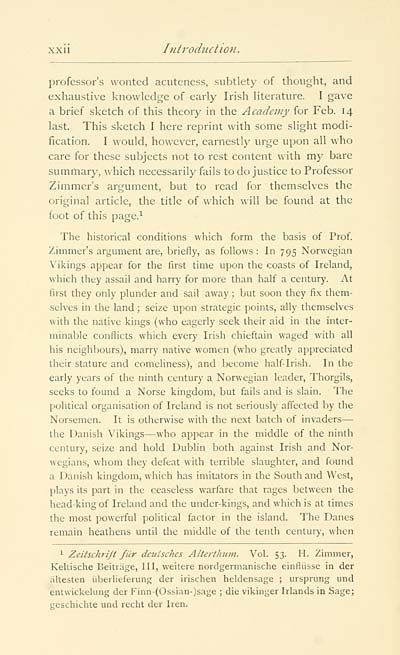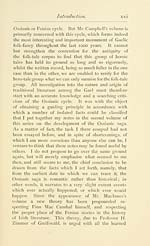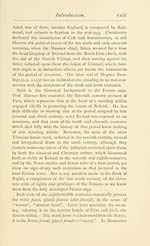Download files
Complete book:
Individual page:
Thumbnail gallery: Grid view | List view

Introduction.
professor's wonted acuteness, subtlety of thought, and
exhaustive knowledge of early Irish literature. I gave
a brief sketch of this theory in the Academy for Feb. 14
last. This sketch I here reprint with some slight modi-
fication. I would, however, earnestly urge upon all who
care for these subjects not to rest content with my bare
summary, which necessarily fails to do justice to Professor
Zimmcr's argument, but to read for themselves the
original article, the title of which will be found at the
foot of this page.^
The historical conditions which form the basis of Prof.
Zimmcr's argument are, briefly, as follows: In 795 Norwegian
Vikings appear for the first time upon the coasts of Ireland,
which they assail and harry for more than half a century. At
first they only plunder and sail away ; but soon they fix them-
selves in the land ; seize upon strategic points, ally themselves
with the native kings (who eagerly seek their aid in the inter-
minable conflicts which every Irish chieftain waged with all
his neighbours), marry native women (who greatly appreciated
their stature and comeliness), and become half Irish. In the
early years of the ninth century a Norwegian leader, Thorgils,
seeks to found a Norse kingdom, but fails and is slain. The
political organisation of Ireland is not seriously affected by the
Norsemen. It is otherwise with the next batch of invaders —
the Danish Vikings — who appear in the middle of the ninth
century, seize and hold Dublin both against Irish and Nor-
wegians, whom they defeat with terrible slaughter, and found
a Danish kingdom, which has imitators in the South and West,
plays its part in the ceaseless warfare that rages between the
head-king of Ireland and the under-kings, and which is at times
the most pow^erful political factor in the island. The Danes
remain heathens until the middle of the tenth century, when
^ Zeitschrijt fiir deiiisches AltertJmm. Vol. 53. H. Zimmer,
Keltische Beitriige, III, weitere nordgermanische einfliisse in der
iiltesten iiberlieferung der irischen heldensage ; ursprung und
entwickelung der Finn-(Ossian-)sage ; die vikinger Irlands in Sage;
geschichte und recht der hen.
professor's wonted acuteness, subtlety of thought, and
exhaustive knowledge of early Irish literature. I gave
a brief sketch of this theory in the Academy for Feb. 14
last. This sketch I here reprint with some slight modi-
fication. I would, however, earnestly urge upon all who
care for these subjects not to rest content with my bare
summary, which necessarily fails to do justice to Professor
Zimmcr's argument, but to read for themselves the
original article, the title of which will be found at the
foot of this page.^
The historical conditions which form the basis of Prof.
Zimmcr's argument are, briefly, as follows: In 795 Norwegian
Vikings appear for the first time upon the coasts of Ireland,
which they assail and harry for more than half a century. At
first they only plunder and sail away ; but soon they fix them-
selves in the land ; seize upon strategic points, ally themselves
with the native kings (who eagerly seek their aid in the inter-
minable conflicts which every Irish chieftain waged with all
his neighbours), marry native women (who greatly appreciated
their stature and comeliness), and become half Irish. In the
early years of the ninth century a Norwegian leader, Thorgils,
seeks to found a Norse kingdom, but fails and is slain. The
political organisation of Ireland is not seriously affected by the
Norsemen. It is otherwise with the next batch of invaders —
the Danish Vikings — who appear in the middle of the ninth
century, seize and hold Dublin both against Irish and Nor-
wegians, whom they defeat with terrible slaughter, and found
a Danish kingdom, which has imitators in the South and West,
plays its part in the ceaseless warfare that rages between the
head-king of Ireland and the under-kings, and which is at times
the most pow^erful political factor in the island. The Danes
remain heathens until the middle of the tenth century, when
^ Zeitschrijt fiir deiiisches AltertJmm. Vol. 53. H. Zimmer,
Keltische Beitriige, III, weitere nordgermanische einfliisse in der
iiltesten iiberlieferung der irischen heldensage ; ursprung und
entwickelung der Finn-(Ossian-)sage ; die vikinger Irlands in Sage;
geschichte und recht der hen.
Set display mode to: Large image | Transcription
Images and transcriptions on this page, including medium image downloads, may be used under the Creative Commons Attribution 4.0 International Licence unless otherwise stated. ![]()
| Early Gaelic Book Collections > Ossian Collection > Waifs and strays of Celtic tradition > Volume 4 > (28) |
|---|
| Permanent URL | https://digital.nls.uk/82446264 |
|---|
| Description | IV. The Fians, Gaelic & English. |
|---|---|
| Shelfmark | Oss.279 |
| Attribution and copyright: |
|
| Description | Selected books from the Ossian Collection of 327 volumes, originally assembled by J. Norman Methven of Perth. Different editions and translations of James MacPherson's epic poem 'Ossian', some with a map of the 'Kingdom of Connor'. Also secondary material relating to Ossianic poetry and the Ossian controversy. |
|---|
| Description | Selected items from five 'Special and Named Printed Collections'. Includes books in Gaelic and other Celtic languages, works about the Gaels, their languages, literature, culture and history. |
|---|

